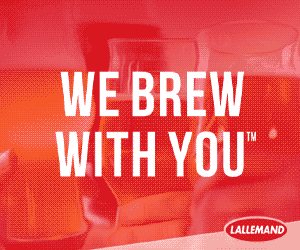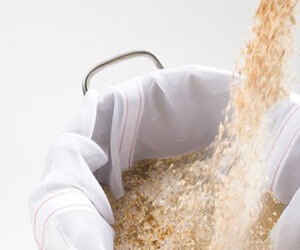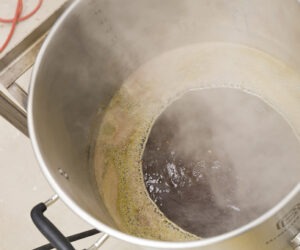High-Gravity Blending to Boost Homebrew Volume
One of the greatest thrills in homebrewing is supplying the beer for a special event. You probably won’t be brewing for too long before someone asks — or you volunteer — to supply beer for a large gathering. My wife and I are both homebrewers and when we got married we wanted the homebrew to flow freely. At the time, however, we didn’t have a lot of time or fermenter space. In order to increase the output of our homebrewery, we turned to high-gravity brewing — brewing a strong beer and diluting it to its target strength when the beer is bottled or kegged. This practice is also called standardization or blending.
High-gravity brewing (or blending) is a technique the big US brewers use. American Pilsners are brewed with an original gravity (OG) around 14–16 °Plato (SG 1.056–1.064). After fermentation, the strong beer is diluted to a virtual OG of around 10–11 °Plato (1.040–1.044). The big breweries brew this way because they can produce more beer with high-gravity brewing than if they brewed it all at working strength. A fermenter that holds 500 barrels of beer will end up producing 700 barrels of beer. For homebrewers, a 5-gallon (19-L) batch of strong beer can easily be diluted to yield 6–6.5 gallons (23–25 L) of finished beer, more if you’re careful.
The beer is not “watery”
In order to successfully practice high-gravity brewing, you need to be able to produce a decent strong beer as the base beer. If you can do that, the dilution technique itself is very simple.
Contrary to popular homebrewing wisdom, high-gravity brewing does not produce “watery” or thin-bodied beers. In fact, many craft breweries (New Belgium, for one) use this technique to produce “full-bodied” beers. Simple math can demonstrate why this is.
Let’s say you wanted to brew 5 gallons (19 L) of beer in the usual manner at an original gravity of 12 °Plato (SG 1.048). If you use a yeast strain with an attenuation of 75%, it will finish at a final gravity (FG) of 3 °Plato (SG 1.012). Now let’s say you wanted to brew the same beer using high-gravity techniques. You brew 5 gallons (19 L) of base beer at 15 °Plato (SG 1.060) and then dilute it to 6.25 gallons (24 L), corresponding to a virtual OG of 12 °Plato (SG 1.048). If you used the same yeast — with the same 75% attenuation figure — your pre-dilution base beer would finish at 3.75 °Plato (SG 1.015). Upon dilution, your diluted FG would be 3 °Plato (SG 1.012) — same as it was with the normally-brewed batch. Because strong beers finish at higher FGs, diluted beers end up at the FG they would have obtained had they been brewed at their virtual OG using normal brewing procedures.
Of course, U.S.-style Pilsners do not exhibit much body. These beers are brewed with 30–40% corn or rice as an adjunct. As a result, there are fewer nonfermentable carbohydrates in them compared with all-malt beers. The rate of adjunct usage, not the blending technique, causes the low body of U.S.-style Pilsners.
Easy recipe calculations
The easiest way to formulate a high-gravity brewing recipe is to take a recipe for one volume and expand it to the larger target volume. However, you should brew the beer at the original volume. To calculate how much to expand the recipe, divide the larger volume of target beer by the smaller volume of strong beer.
For example, let’s say you have a 5-gallon (19 L) pale ale recipe with 10 lbs. (4.5 kg) pale malt, 1 lb. (0.45 kg) crystal malt and 2 oz. (56 g) of bittering hops. If you want to end up with 6 gallons (23 L) of beer, multiply all the ingredients by 6 divided by 5, or 1.2. You’d end up with 12 lbs. (5.4 kg) pale malt, 1.2 lbs (0.54 kg) and 2.4 oz (68 g) of hops. Brew 5 gallons (19 L) of this beer and dilute it to 6 gallons (23 L).
A drawback to this simple calculation method is that hop utilization slightly decreases at higher wort gravities. Thus, using proportionally more hops in your high-gravity base beer may lead to an underhopped diluted beer. However, in most cases, this discrepancy will be minimal.
Complete recipe calculations
To completely master high-gravity brewing calculations, all you need to know is one simple formula:
C1V1 = C2V2
where C is concentration and V is volume. The subscripts refer to the initial strong beer and resulting blended beer.
For calculating gravity, use “gravity points” — the decimal portion of specific gravity as an integer. For example, a specific gravity of 1.045 equals 45 “gravity points.” If you had 5 gallons (19 L) of wort at a specific gravity of 1.064, what would the gravity become if you diluted it to 7 gallons (26 L)? Substituting the values into the equation, we get 64(5) = X(7). Solving for X, we get 64(5)/7 = 45.7, or a specific gravity of almost 1.046. You can also use degrees Plato for these calculations.
You can use IBUs and SRM values as a concentration (C) in these equations for calculating bitterness and color values. For example, if your 5-gallon (19-L) batch of beer had 50 IBUs, the equation 50(5) = X (7) would give you the resulting IBUs in your 7-gallon (26-L) final beer. (It would be 35.7 IBUs.)
Using brewing software you can calculate your OG, IBUs and SRM for your strong beer. Then, you can calculate the values for the diluted beer using the “CV” formula. This way, the influence of wort gravity on bitterness will be taken into consideration.
Brewing the base beer
Brew your base beer as you would any strong beer. The quality of your final beer will depend primarily on how well the fermentation of your strong beer went. Fermentation byproducts, such as esters and higher alcohols (fusel oils), are produced at a disproportionally greater rate in “thick” worts than in “thin” ones. At higher dilution rates, you may notice that your finished beer is a bit more estery than it would have been had you brewed it normally. If your final beer tastes too estery, has fusel notes or other unwanted fermentation byproducts, you’ve pushed the technique too far. At higher dilution rates, you may also need to tinker with your recipe a bit to get the beer to taste as you want it.
The big breweries typically do not exceed 16 °Plato (SG 1.064) when brewing their strong beer for dilution. Above this gravity and the resulting blended lager is too estery. For most lagers to be blended, 16 °Plato (SG 1.064) is a reasonable maximum starting gravity for the strong base beer.
When brewing ales, the amount of esters in the beer can be manipulated not only by practicing good fermentation practices but also by picking an appropriate yeast strain. A neutral yeast strain — like Wyeast 1056 or White Labs WLP001 — will ferment cleanly at high gravities and yield acceptable finished beers. I’ve had good results brewing ales up to 21 °Plato (SG 1.084) and diluting them to 16 °Plato (SG 1.064). The upper gravity limit for ales depends on your own tolerance of the final ester levels in your beer.
Whether brewing a lager or an ale, let your beer ferment completely and condition for an appropriate amount of time. The dilution step occurs when the beer is ready to be bottled or kegged. Whether bottling or kegging your beer, you will prepare your dilution water the same way.
Preparing the dilution water
Your dilution water should taste good and be free of chlorine or chloramines. As when you prepare your brewing liquor, carbon filtering your tap water should yield acceptable dilution water. There is no need to add calcium or other “brewing salts” to your dilution water.
Under most normal circumstances, water has some oxygen dissolved in it. At 68 °F (20 °C), pure water that is exposed to air will have 9.0 parts per million (ppm) oxygen at equilibrium. This amount decreases at higher temperatures.
When you dilute your beer, you don’t want to introduce oxygen into it. Oxygen will cause the beer to go stale faster than it normally would, resulting in cardboard-like aromas or sherry-like flavors. So, you need to remove the oxygen from your dilution water.
One way commercial breweries remove oxygen from their water is by heating it and spraying it into a vacuum chamber. The resulting water contains less than 50 parts per billion (ppb) oxygen. Obviously, you probably don’t have the specialized equipment for this lying around your home brewery. Fortunately, there’s an easier way to deaerate water.
To reduce the oxygen content of your dilution water, boil it vigorously for 15 minutes. I usually measure out the amount of water I need for dilution plus about 5% to account for evaporation. After boiling, cool the water as quickly as possible. Putting your pot in an ice bath works well for this. Be careful not to splash or agitate the water while chilling as you will reintroduce oxygen into the water. Unless you have a way of storing your dilution water under CO2, you should prepare it immediately prior to use. Immediately after boiling, your water will contain less than 1 ppm oxygen.
If you are paranoid about oxygen, you can also add an antioxidant to the dilution water. A quarter teaspoon of ascorbic acid (vitamin C) added to 5 gallons (19 L) of just-blended beer will do the trick.
For bottle conditioned beers, adding ascorbic is absolutely unnecessary. The active yeast that condition the beer in the bottle should quickly take up any oxygen that might be in the brew. For force carbonated kegs, adding a pinch of yeast is also an option. (Keep in mind that, unless you filtered it, your beer already has a small amount of yeast in suspension.)
If you boil your water, quickly cool it and use it immediately, you shouldn’t need to take any additional steps to reduce your beer’s oxygen content. I’ve never used ascorbic acid, or added yeast to my kegged beers, and I’ve never had a problem with premature staling in my blended homebrews.
Diluting when bottling
If you are bottling your beer, begin by quietly transferring your dilution water to your bottling bucket. Siphon the water or pour very carefully, don’t just dump it in. Next, add your bottling sugar then rack your beer on top of the water and sugar. (Note: you can boil your bottling sugar in your dilution water to save a step.) Siphoning the beer into the water should be sufficient to mix it thoroughly. However, it never hurts to stir the beer quietly (slowly and without splashing) to be sure. Once you’ve mixed the water and beer, bottle and condition as you normally would.
Many bottling buckets hold over 5 gallons (19 L) of beer, so you will probably be able to handle at least 6 gallons (23 L) of blended beer. If your bottling bucket is not large enough to hold all the diluted beer, you have two options. The first is simply to bottle the batch in two shifts. The second is to bottle some beers as undiluted base beer first, then siphon in the dilution water when there’s enough room in the bucket. If you do this, remember to adjust your dilution calculations accordingly.
Diluting when kegging
If you are kegging your beer, begin by filling the keg with CO2. To do this, fill the keg with water and push all the water out with CO2. At this point, you’ve replaced the water in the keg with CO2. Next, vent the excess pressure and open the keg lid. Rack the dilution water into the keg followed by the base beer. Finally, replace the keg lid, turn on the CO2 and force carbonate. (You may want to vent the keg a couple times with the CO2 on to blow off any oxygen in the headspace.)
If you brew 5-gallon (19-L) batches and keg your beer in the standard 5-gallon (19-L) Cornelius keg, you will always have beer left over if you plan on diluting it. There are a couple possible solutions to this problem. The simplest is to split the beer into two kegs. Another is to force carbonate the keg, then bottle off some of the strong base beer with a counter-pressure bottler. Once you’ve bottled a volume of beer equal to the planned amount of dilution water, add the water to the keg.
If you frequently dilute high-gravity beers and have a kegging system, there is one “trick” you can use to make the diluting step fast and easy. Prepare an entire keg of de-aerated water by boiling 5 gallons (19 L) of water, cooling it and siphoning it to a keg. Force carbonate the keg so you have 5 gallons (19 L) of carbonated water. When you brew your base beer, keg it and force carbonate. When it comes time to dilute the beer, use a “jumper” to move the (carbonated) water into the (carbonated) beer keg. A “jumper” is just a normal beer line with “beer out” connections on both ends. Connect the “beer out” side of the water keg to the “beer out” side on the receiving beer keg. Release the pressure on the beer keg and open the lid. Push water from the water keg to the strong beer keg though the dip tubes on both kegs. Once the correct level is reached in the receiving keg, disconnect the “beer out” line from the water keg.
There are two advantages to using a carbonated water keg for dilution. Beer diluted this way is ready to serve since both the beer and water are carbonated before you blend them. Secondly, you can always quickly “expand” your existing kegged beer supplies if you need to.
Applications
High gravity brewing can be used for making many styles of beer, although it is most commonly associated with American Pilsners. It works best when you are planning to make a low to moderate-strength beer.
The first time you try this technique, consider using about 10–20% dilution water. Adding dilution water at a volume of less than 10% of your beer’s volume — in my opinion — does not yield enough extra beer to be worthwhile.
For a 20% dilution, you could make 5 gallons (19 L) of beer at a specific gravity of 1.058 (14.4 °Plato) and dilute it to 6 gallons (23 L) of beer at 1.048 (12 °Plato). If you bottle, this will result in almost 11 more 12 oz. (355 mL) bottles than a standard 5-gallon (19-L) batch.
For beers diluted at a 10–20% rate, you should be able to simply scale up any beer recipe and brew it slightly stronger. The diluted beer should not taste noticeably different from the same beer brewed in the normal way.
If you try high gravity brewing and like it, you can try adding more dilution water to yield more finished beer. It’s not too hard to brew a good beer with 30% dilution water. And, if you really want to push it, you could try going to 40%. At 40%, you’d end up with 7 gallons (26 L) of beer from your 5-gallon (19-L) base batch. The biggest drawback to keep an eye out for is unacceptably high ester levels in your finished beer.
The second problem to watch out for in high-gravity brewed beers is early staling. With increasing amounts of dilution water, you are introducing more oxygen into your beer. I wouldn’t recommend large dilutions if you are planning to store your beer for long periods (over, say, 6 months). Conversely, if you are diluting fresh beer for a big party in which you expect all the beer to be consumed, you can attempt to maximize your amount of beer as it takes awhile for staling products to develop. Use some sense when diluting, however. Always remember that 6 gallons (23 L) of good homebrew is better than 7 gallons (26 L) of undrinkable swill.
I brew most of my beers the normal way. However, I’ll use high gravity brewing when I’m low on beer or if I want to make two beers — a strong one and a regular one — from the same batch. Don’t let the fact that this technique is mostly used to produce “fizzy yellow water” dissuade you from adding this useful technique to your set of brewing skills.



